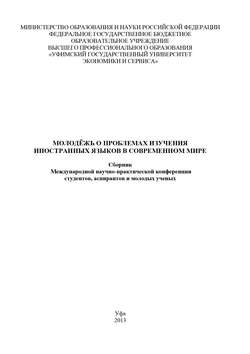Читать книгу Молодежь о проблемах изучения иностранных языков в современном мире - Коллектив авторов - Страница 4
INTERCULTURAL COMMUNICATIONS AND TRANSLATING FROM ENGLISH INTO NON-ENGLISH LANGUAGES
ОглавлениеУДК 81-22
BAKIROVA A.
Ufa State University of Economics and Service (Ufa)
Intercultural communications relates to cultural competence. Interacting with people of different backgrounds is important in the modern day world and understanding the cultural context, background, and upbringing of the people around you, can allow a better relationship to develop.
Intercultural communication is laden with difficulties. Even with the progressive globalization of the modern world, language continues to be a barrier to effective communication. If you have ever studied a foreign language or spoken with someone for whom English is a second language, you are aware that many speech patterns and common expressions simply do not translate well. Although nonverbal intercultural communication is less frequently explored, it is still extremely important. From hand gestures to bowing, nonverbal communication is crucial in every culture. Understanding the common issues associated with intercultural communication can lead to more effective communication with people from different cultures.
Knowing how to speak two languages is not the same thing as knowing how to translate. Translation is a special skill that professionals work hard to develop.
When an advanced translator takes on a job they keep in mind the numerous aspects that go beyond simply translating the literal English translation. These aspects include:
• Cultural nuances
• Document structure
• Context
• Composition
• Accurate dialect/colloquialism
• Understood target audience
Why is English Translation Difficult?
There are several, unique aspects of the English language that cause English translation into another language to be quite challenging. One of these difficulties includes the verb-adverb concept that is distinct to English. This concept includes combinations like “turn on,” “turn off,” “mark up,” or “mark down.” It can be quite difficult for translators to reflect this as other languages only use single specific verbs instead of the English verb-adverb combinations.
Another reason English translation into another language is so difficult is because of how English incorporates articles. Even though nearly every Western European languages use articles, a significant amount of other languages do not.
English Translation to Spanish Translation.
In the translation process, a significant detail a translator must take into account is the target market. This is especially critical when it comes to Spanish translations, since there are so many countries and cultures where it is spoken with subtle differences.
Despite the fact that some say there is a universal Spanish language that can be attained by using general terminology (understood in most regions), it is known that each country or region has its own colloquialism, unique expressions, ways of addressing people, and ways of using tenses.
This is undoubtedly the chief feature that should be kept in mind when translating an English translation into Spanish. Translating for a market in Spain is vastly different than translating for a market in Argentina, Mexico or the Spanishspeaking community in the US.
English Translation of Proverbs.
Proverbs, clichés and idioms are a notable examples that displays the process and complexities of English translation. This is especially pertinent in languages that belong to different families like English and Arabic. If there is no exact equivalent, the translator must find a suitable translation. This is why it is so important for the translator to translate from his/her mother tongue.
To illustrate, the English proverb “diamond cut diamond” has no exact Arabic equivalent. The proverb would not make sense in the target language (Arabic) if it were rendered literally. That is why, for this example, the translator must be a native English speaker so they are able to adequately understand the exact meaning of the proverb and reflect it with a suitable Arabic translation. Only highly experienced and knowledgeable translators are able to accurately transpose such information.
References
1. Nataly Kelly, Jost Zetzsche « Found in Translation: How Language Shapes Our Lives and Transforms the World»
2. http://www.7brands.com/translation-articles/target-language/englishtranslation/english.htm
3. http://www.lifescript.com/soul/self/growth/intercultural_communication_su rviving_in_a_global_world.aspx
